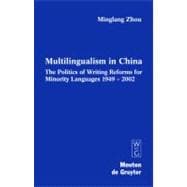
Note: Supplemental materials are not guaranteed with Rental or Used book purchases.
Purchase Benefits
What is included with this book?
| Preface | vii | ||||
| Acknowledgements | ix | ||||
| List of tables | xvi | ||||
| Abbreviations and names of minorities in China | xx | ||||
| Map 1 Distribution of minority nationalities and languages in China | xxiii | ||||
| Map 2 China: Autonomous regions and prefectures | xxiv | ||||
| Chapter 1 Minorities and minority languages in China | 1 | (35) | |||
|
2 | (6) | |||
|
8 | (7) | |||
|
15 | (6) | |||
|
21 | (1) | |||
|
21 | (12) | |||
|
33 | (3) | |||
| Chapter 2 The politics of minority language policy, 1949-2002 | 36 | (63) | |||
|
37 | (3) | |||
|
40 | (2) | |||
|
42 | (18) | |||
|
43 | (2) | |||
|
45 | (2) | |||
|
47 | (4) | |||
|
51 | (4) | |||
|
55 | (5) | |||
|
60 | (17) | |||
|
61 | (1) | |||
|
62 | (6) | |||
|
68 | (4) | |||
|
72 | (5) | |||
|
77 | (22) | |||
|
77 | (6) | |||
|
83 | (5) | |||
|
88 | (5) | |||
|
93 | (6) | |||
| Chapter 3 The politics of the status of writing systems: Official, experimental, or unofficial | 99 | (54) | |||
|
101 | (10) | |||
|
101 | (4) | |||
|
105 | (6) | |||
|
111 | (10) | |||
|
112 | (4) | |||
|
116 | (5) | |||
|
121 | (30) | |||
|
122 | (4) | |||
|
126 | (10) | |||
|
136 | (5) | |||
|
141 | (7) | |||
|
148 | (3) | |||
|
151 | (2) | |||
| Chapter 4 Choices of scripts and theories of writing systems: East vs. West | 153 | (56) | |||
|
158 | (11) | |||
|
161 | (4) | |||
|
165 | (4) | |||
|
169 | (27) | |||
|
171 | (6) | |||
|
177 | (10) | |||
|
187 | (9) | |||
|
196 | (13) | |||
|
198 | (5) | |||
|
203 | (6) | |||
| Chapter 5 The politics of vernacular writing systems | 209 | (71) | |||
|
211 | (18) | |||
|
214 | (5) | |||
|
219 | (10) | |||
|
229 | (9) | |||
|
231 | (2) | |||
|
233 | (5) | |||
|
238 | (36) | |||
|
238 | (7) | |||
|
245 | (6) | |||
|
251 | (7) | |||
|
258 | (4) | |||
|
262 | (4) | |||
|
266 | (5) | |||
|
271 | (3) | |||
|
274 | (6) | |||
| Chapter 6 The politics of traditional and reformed writing systems | 280 | (67) | |||
|
281 | (9) | |||
|
290 | (9) | |||
|
299 | (11) | |||
|
310 | (20) | |||
|
312 | (4) | |||
|
316 | (7) | |||
|
323 | (7) | |||
|
330 | (13) | |||
|
330 | (5) | |||
|
335 | (8) | |||
|
343 | (4) | |||
| Chapter 7 Modernization: The politics and sociolinguistics of Chinese loanwords and minority language orthography | 347 | (42) | |||
|
349 | (6) | |||
|
355 | (6) | |||
|
361 | (6) | |||
|
367 | (6) | |||
|
373 | (5) | |||
|
378 | (6) | |||
|
384 | (5) | |||
| Chapter 8 Conclusion | 389 | (13) | |||
|
390 | (2) | |||
|
392 | (3) | |||
|
395 | (3) | |||
|
398 | (2) | |||
|
400 | (2) | |||
| Notes | 402 | (5) | |||
| References | 407 | (40) | |||
| Subject index | 447 | (7) | |||
| Index of (officially recognized) minority nationalities and minority languages in China | 454 | (3) | |||
| Index of names of influencial persons | 457 |
The New copy of this book will include any supplemental materials advertised. Please check the title of the book to determine if it should include any access cards, study guides, lab manuals, CDs, etc.
The Used, Rental and eBook copies of this book are not guaranteed to include any supplemental materials. Typically, only the book itself is included. This is true even if the title states it includes any access cards, study guides, lab manuals, CDs, etc.